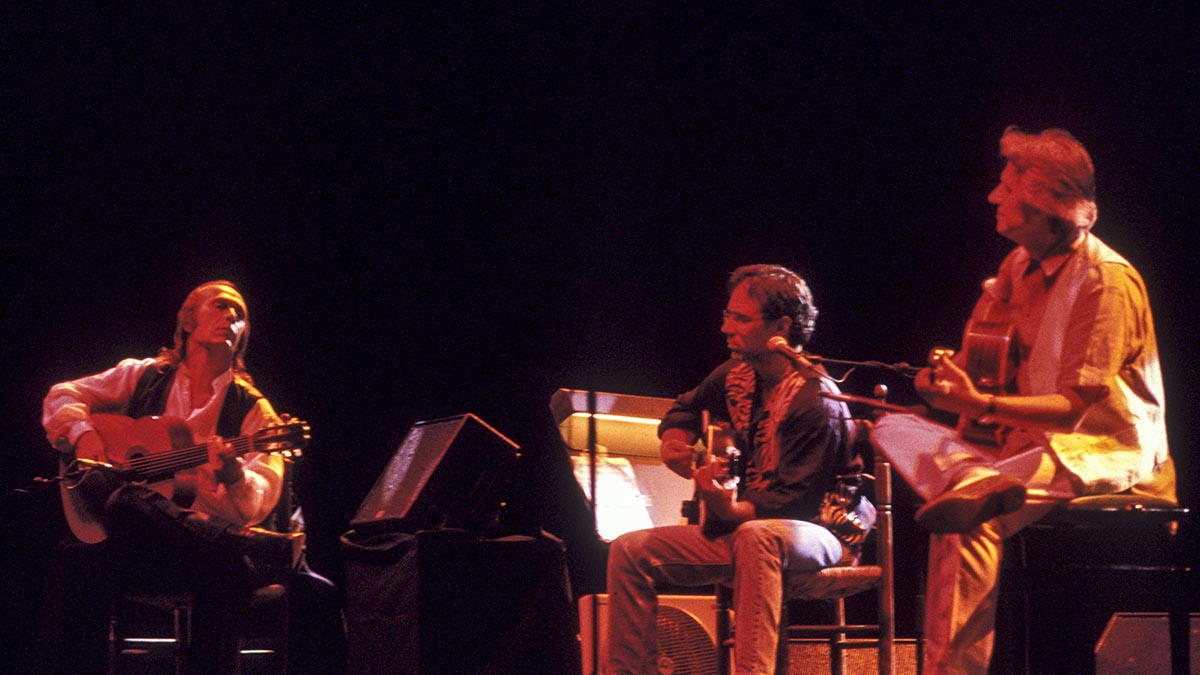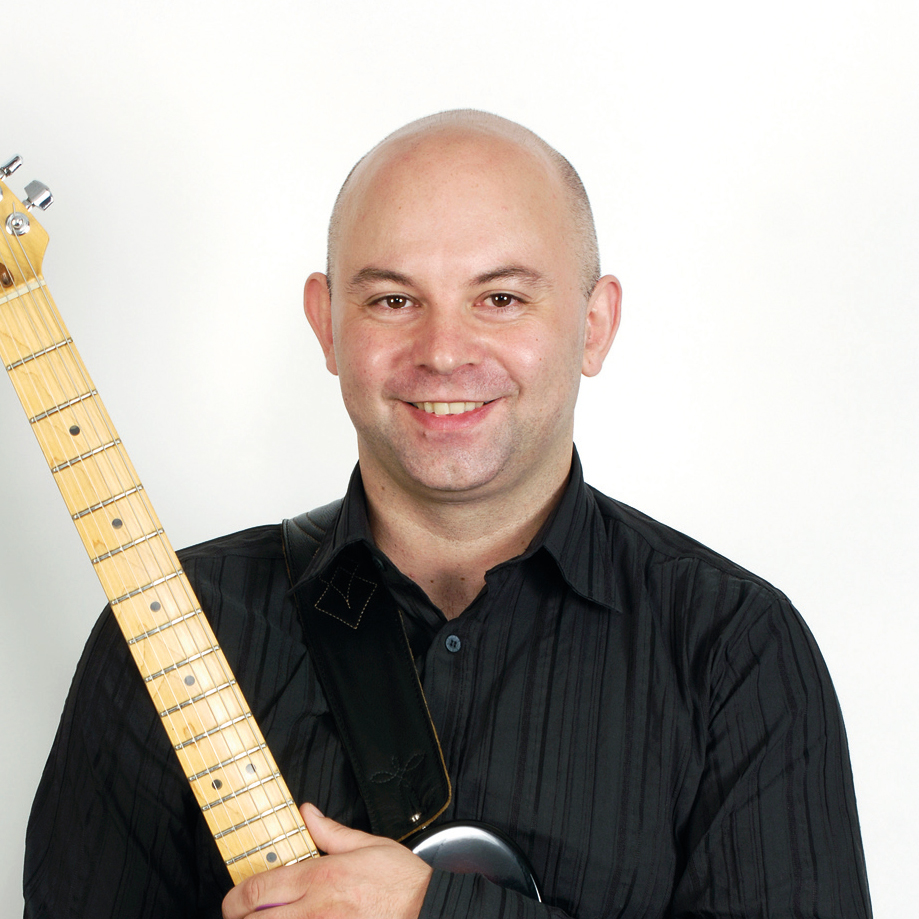Show-stopping techniques you can learn from Paco de Lucia, Al Di Meola and John McLaughlin
This lesson takes a deep dive into the styles of the virtuoso trio responsible for one of the greatest guitar albums ever made

Friday Night In San Francisco is a legendary instrumental guitar album featuring a guitar trio of American picking tornado Al Di Meola, fingerstyle flamenco titan Paco De Lucia and jazz-fusion superstar John McLaughlin.
Recorded at The Warfield Theatre on 5th December 1980, the premise was remarkably simple, with just three acoustic guitars performing a mixture of pieces composed by all three members, and with improvisation and musical interplay to the fore. The accompanying tour was a a raging success and the album has since gone on to become considered one of the most influential guitar recordings of all time.
All three players had previously enjoyed successful careers prior to this Super Guitar Trio, John with Miles Davis, Mahavishnu Orchestra and Shakti, Al with Chick Corea’s Return To Forever and Paco had achieved legendary status in his native Spain remarkably young, accompanying dancer Jose Greco at age 12.
Al and Paco had collaborated previously too on Di Meola’s Elegant Gypsy record (Columbia 1977). In fact, an embryonic version of the trio, featuring the fusion pioneer Larry Coryell in place of Di Meola played in exactly the same format at the Royal Albert Hall on Valentine’s Day 1979, a year before San Francisco.
While it’s always a good time to look at the playing of these three acoustic guitar superstars, the timing now is particularly appropriate as a new release has recently hit the shelves. Saturday Night In San Francisco is the previously lost sequel, recently rediscovered and remixed by Al Di Meola and his team, featuring entirely new material but with the trio in equally blistering form.
Although the playing style and technique of all three players is vastly different, there is also a great deal of common ground that we can explore.
Paco adopts a purely fingerstyle nylon-string approach with the entire history of flamenco at his disposal but with an exploratory improvisational spirit that takes his playing into new areas.
All the latest guitar news, interviews, lessons, reviews, deals and more, direct to your inbox!
Al has terrifying alternate picking technique and a highly charged and highly developed rhythmic sensibility that allows him to play at exhilarating breakneck speeds but with remarkable rhythmic precision and control, while John’s command of rhythmically varied and intervallically diverse vocabulary showcases an innate understanding of the language of jazz, flamenco, traditional Indian music and much more besides.
The musical examples that follow are designed to break down some of the concepts, techniques and musical approaches that you can clearly hear each player use on both Friday and Saturday’s recordings.
Example 1 is devoted to ideas used by Paco, Al, John and even Larry, and while this is just one instance of application for each idea, it opens the door to further study, exploration and experimentation.
In Example 2, we see how these ideas could be expressed in more blues and blues-rock based playing, taking the exact same concepts, techniques and approaches and transferring them to more electric based styles.
Example 3 features an intricate composed part that alternates between arpeggio-based figures and single note lines, played by the trio in tight unison. Remember, if these licks and lines feel a little out of reach then just take one idea per session, slow down and come back to it over an extended period of time.
Get the tone
Amp Settings: Gain 2, Bass 4, Middle 5, Treble 6, Reverb 5
At this point, both John and Al favoured Ovation acoustics played with a pick, using a combination of under-saddle piezo and a mic close to the soundhole. Al was using a steel-string model while John chose nylon.
Paco stuck to his Hermanos Conde flamenco guitar straight into a microphone with no internal pickup. It’s worth noting that on the recording there is a lot of reverb so for once feel free to add as much as you like here.
Exercise 1. Friday Night Lines & Ideas
Our first collection of ideas comes from the Super Guitar Trio of Paco, Al and John, or more accurately Super Guitar Quartet, with an additional phrase from the great Larry Coryell.
Each idea, in the key of A Minor (A-B-C-D-E-F-G), outlines a pair of conceptual approaches ranging from groups of three and open-string cascades, mixed rhythms and palm muting, shifting octaves with open strings and rhythmic displacement and arpeggio pull-offs paired with fast picking.
We occasionally touch on A Harmonic Minor too, so expect to see the occasional G# (maj7th) in examples 1d) and 1e). All of these techniques and approaches can be found in abundance throughout these recordings, so consider these to be just one example of any particular concepts in application.
Exercise 2. Bluesy Expressions
In this section we’re looking at a similar range of ideas, such as groupings of three, open-string cascades, mixed rhythms, palm muting, shifting octaves and arpeggios with pull-offs and fast picking. But here, these concepts are expressed in a more blues or blues-rock style.
You can hear traces of players like Paul Kossoff (2a), Steve Trovato (2b), Joe Bonamassa (2c), Gary Moore (2d), BB King (2e) and even Paul Gilbert here (2f). Although these ideas are commonplace throughout these genres it’s often as much a question of tone and attack to personalise a phrase.
Once again, our notes are predominantly coming from A Minor (A-B-C-D-E-F-G), although there is more here use of A Minor Pentatonic (A-C-D-E-G) and its associated Blues scale (add b5: Eb).
Exercise 3. Unison Part
We end with a challenging unison part, again in the key of A Minor, that uses arpeggiated chords rapidly jumping across the strings.
Aim to let the Am(maj9) chord ring out as long as possible, although you’ll need to break this form to articulate the following F(#11) chord and the punctuating single-note runs that feature in each alternate bar.
While it’s a bold and unique approach to feature three guitars in exact unison, the different guitar types and articulation approaches (See Get The Tone above) produce an impressive and very thick sounding result.
On the audio I’ve removed the central guitar for the backing track, so you can join in and become John McLaughlin! As with all of these examples, patience and time are your friends, so build up speed, accuracy and stamina over multiple sessions, rather than dashing through the material leaving snags, mistakes and unpolished articulation unchecked.
John is Head of Guitar at BIMM London and a visiting lecturer for the University of West London (London College of Music) and Chester University. He's performed with artists including Billy Cobham (Miles Davis), John Williams, Frank Gambale (Chick Corea) and Carl Verheyen (Supertramp), and toured the world with John Jorgenson and Carl Palmer.


